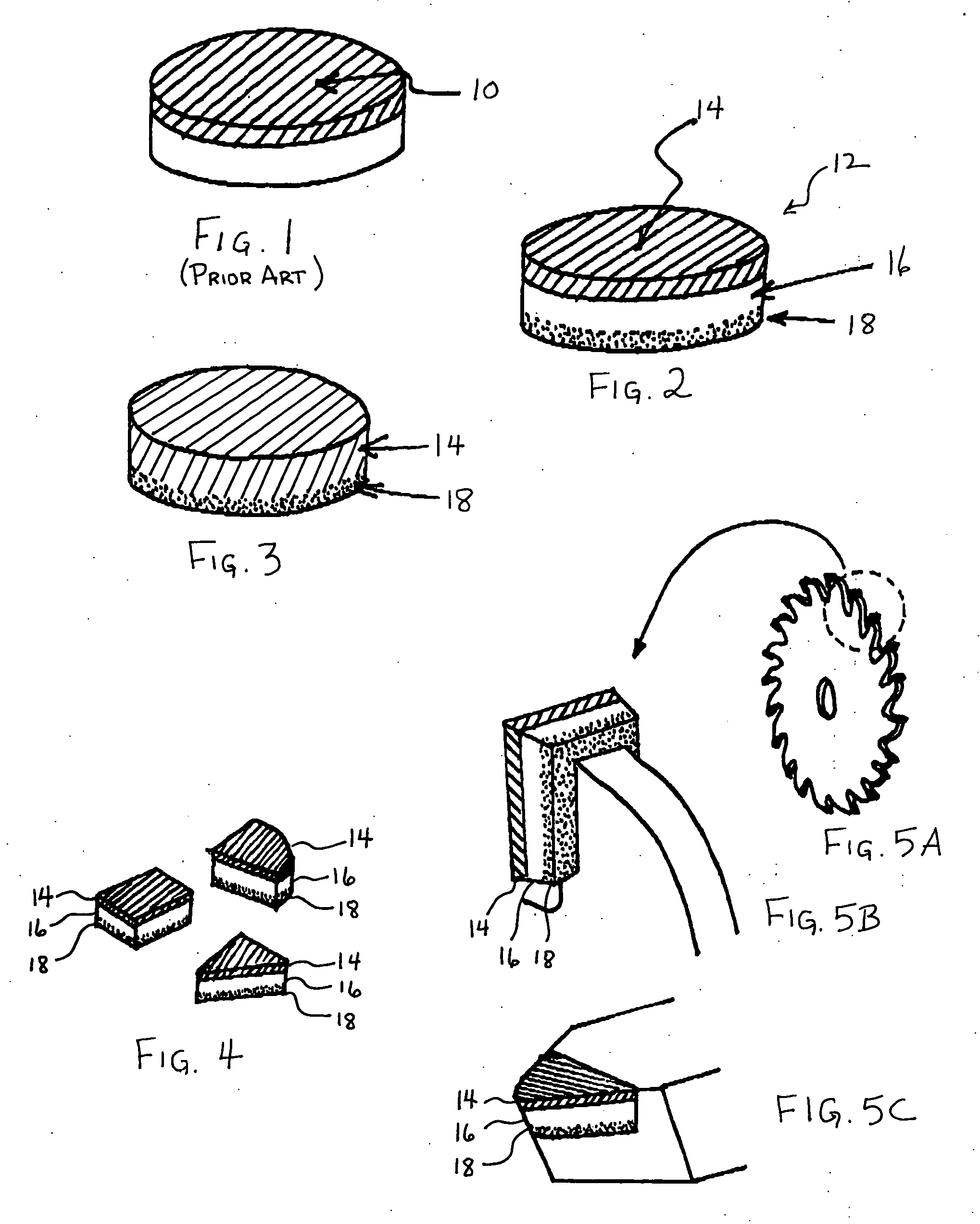Weldable ultrahard materials and associated methods of manufacture
a technology of ultrahard materials and manufacturing methods, applied in the field of ultrahard materials, can solve the problems of high cost, low thermal expansion coefficient of cemented tungsten carbide, poor resistance to thermal shock, etc., and achieve the effect of improving the joint design of pcd attachment, easy machining, and high localization area
- Summary
- Abstract
- Description
- Claims
- Application Information
AI Technical Summary
Benefits of technology
Problems solved by technology
Method used
Image
Examples
example 1
[0060] Typical PCD and PCBN having a 3.2 mm thickness and 38 mm diameter were made under standard HPHT PCD sintering conditions. Laser weldable PCD and PCBN were also formed in accordance with the present invention. All of the raw materials used were the same as for the conventional PCD and PCBN but extra materials for the weldable layer were prepared to allow attachment of the weldable stainless steel layer into the cemented tungsten carbide substrate of PCD and PCBN. The extra materials included a nickel (Ni) disc of 0.15 mm thick (as an intermediate layer) and a 2.0 mm thick 316 stainless steel (SS) disc (primary weldable layer).
[0061] The reaction cup loading was started by loading diamond (for PCD) and CBN (for PCBN) powders in the bottom of separate cups. A WC-disc was placed over the diamond powder followed by a Ni-disc, and then a SS-disc in a tantalum cup. A similar procedure was followed for the cBN powder.
[0062] Sintering of PCD and PCBN was conducted under HPHT conditi...
example 2
[0064] The test of Example 1 was repeated with a cobalt disc placed as a bonding joint between WC-substrate of PCD or PCBN and the SS-disc. The resulting quality of weldable PCD and PCBN appeared substantially similar to the samples of Example 1. Another test was also made with an alloy of cobalt and nickel as a joining / intermediate layer and the final PCD looks good and overall joining quality at the interfaces is as strong as Example 1.
example 3
[0065] A similar test as in Example 1 was carried out with no interface joining metal disc in between WC and SS layer. In this example, the SS-disc as the weldable layer was contacted directly with the WC-disc of PCD and PCBN. Further, another test was also made using only a nickel disc as a weldable layer instead of a SS-disc. The PCD with WC-disc and SS-disc next to WC exhibited good joining at the interface of the WC and SS layers but the bond strength relative to Example 1 was not as good, but was still acceptable for many applications. The PCD made with WC and Ni-layer demonstrates an acceptable joining at the interface of WC / Ni layers and its bond strength is also shown as strong as Example 1 in striking tests.
PUM
| Property | Measurement | Unit |
|---|---|---|
| Temperature | aaaaa | aaaaa |
| Pressure | aaaaa | aaaaa |
| Weldability | aaaaa | aaaaa |
Abstract
Description
Claims
Application Information
 Login to View More
Login to View More - R&D
- Intellectual Property
- Life Sciences
- Materials
- Tech Scout
- Unparalleled Data Quality
- Higher Quality Content
- 60% Fewer Hallucinations
Browse by: Latest US Patents, China's latest patents, Technical Efficacy Thesaurus, Application Domain, Technology Topic, Popular Technical Reports.
© 2025 PatSnap. All rights reserved.Legal|Privacy policy|Modern Slavery Act Transparency Statement|Sitemap|About US| Contact US: help@patsnap.com


